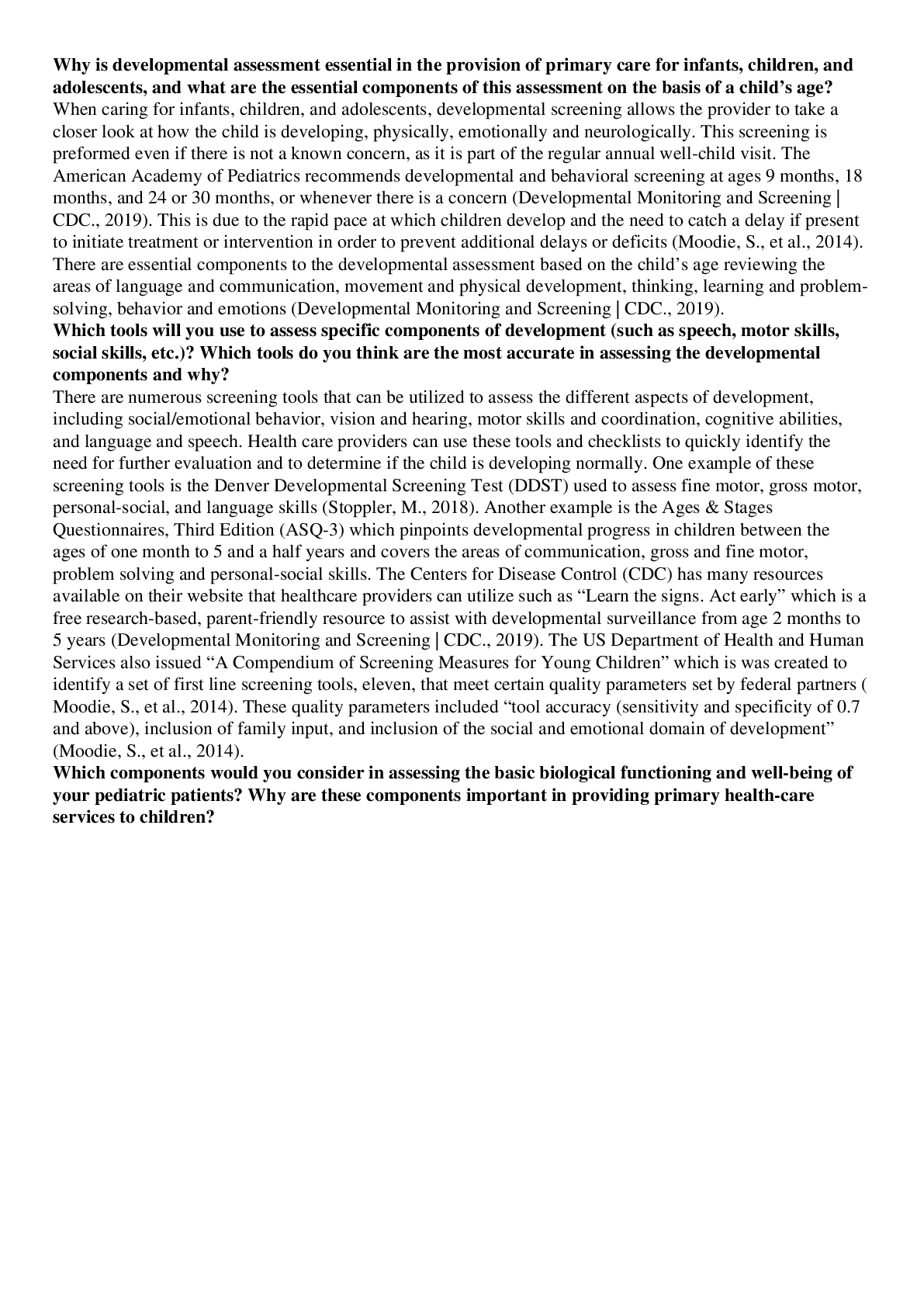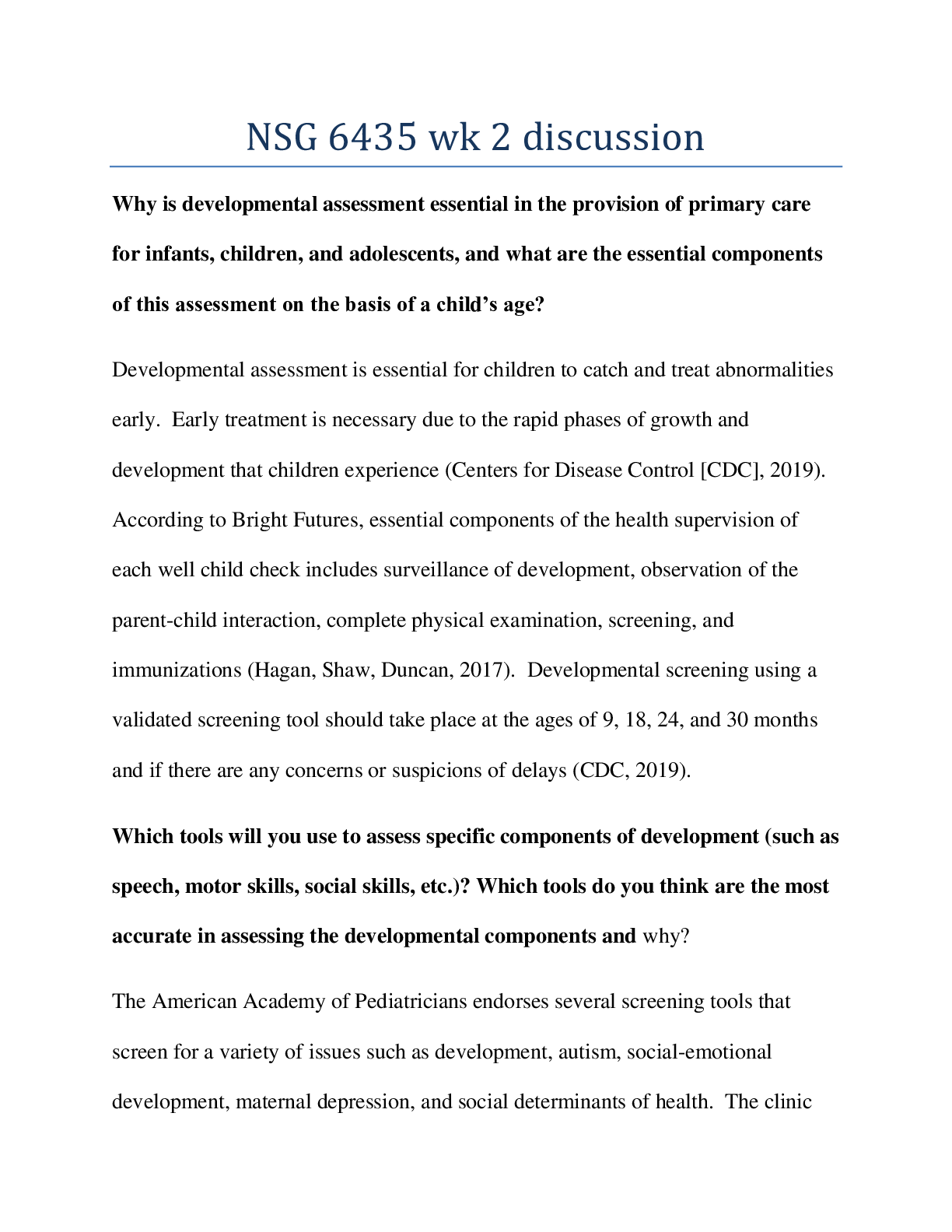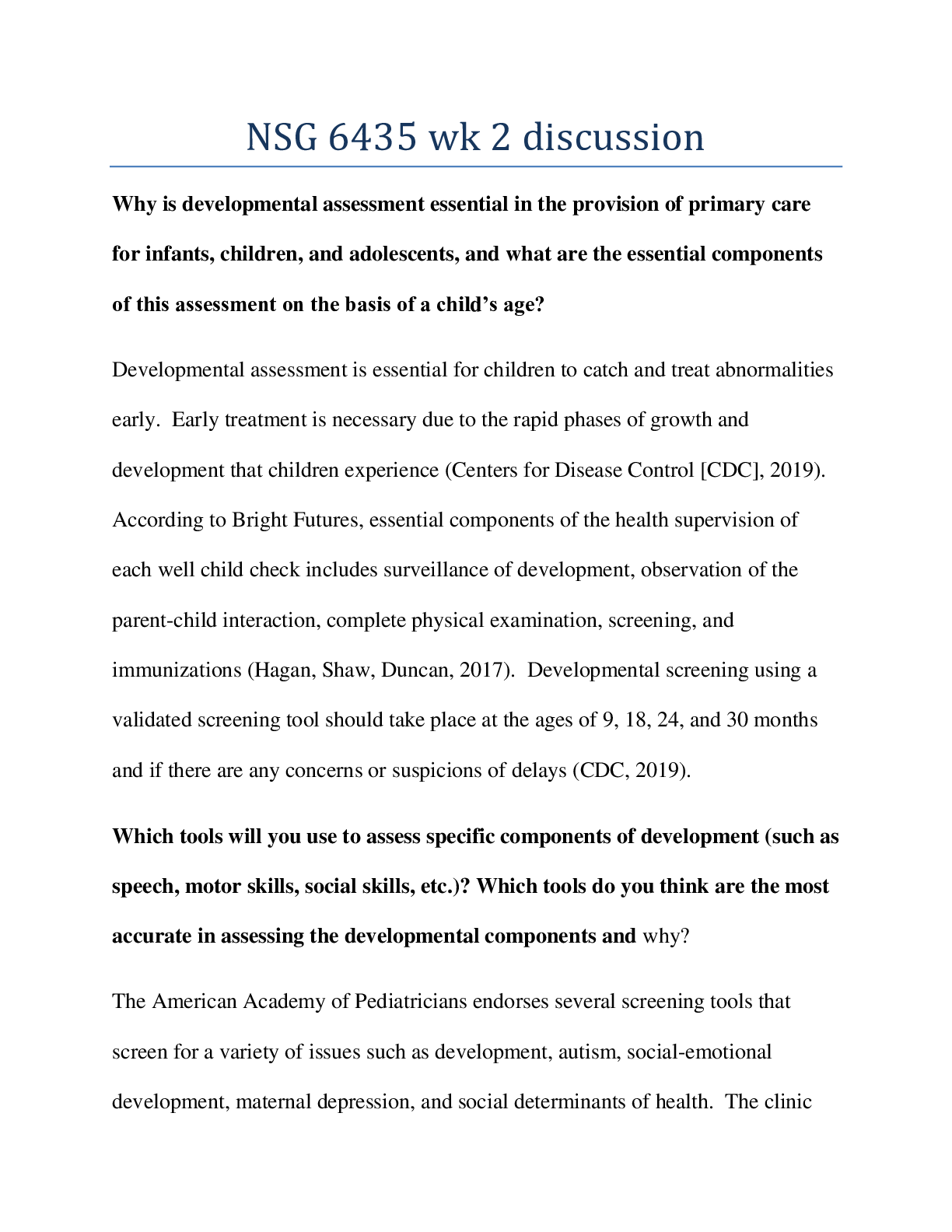Health Care > QUESTIONS & ANSWERS > [Solved] NSG 6435 Week 2 Discussion (All)
[Solved] NSG 6435 Week 2 Discussion
Document Content and Description Below
NSG 6435 Week 2 Discussion Why is developmental assessment essential in the provision of primary care for infants, children, and adolescents, and what are the essential components of this assessmen... t on the basis of a child’s age? When caring for infants, children, and adolescents, developmental screening allows the provider to take a closer look at how the child is developing, physically, emotionally and neurologically. This screening is preformed even if there is not a known concern, as it is part of the regular annual well-child visit. The American Academy of Pediatrics recommends developmental and behavioral screening at ages 9 months, 18 months, and 24 or 30 months, or whenever there is a concern(Developmental Monitoring and Screening | CDC., 2019). This is due to the rapid pace at which children develop and the need to catch a delay if present to initiate treatment or intervention in order to prevent additional delays or deficits (Moodie, S., et al., 2014). There are essential components to the developmental assessment based on the child’s age reviewing the areas of language and communication, movement and physical development, thinking, learning and problem-solving, behavior and emotions (Developmental Monitoring and Screening | CDC., 2019). Which tools will you use to assess specific components of development (such as speech, motor skills, social skills, etc.)? Which tools do you think are the most accurate in assessing the developmental components and why? There are numerous screening tools that can be utilized to assess the different aspects of development, including social/emotional behavior, vision and hearing, motor skills and coordination, cognitive abilities, and language and speech. Health care providers can use these tools and checklists to quickly identify the need for further evaluation and to determine if the child is developing normally. One example of these screening tools is the Denver Developmental Screening Test (DDST) used to assess fine motor, gross motor, personal-social, and language skills (Stoppler, M., 2018). Another example is the Ages & Stages Questionnaires, Third Edition (ASQ-3) which pinpoints developmental progress in children between the ages of one month to 5 and a half years and covers the areas of communication, gross and fine motor, problem solving and personal-social skills. The Centers for Disease Control (CDC) has many resources available on their website that healthcare providers can utilize such as “Learn the signs. Act early” which is a free research-based, parent-friendly resource to assist with developmental surveillance from age 2 months to 5 years (Developmental Monitoring and Screening | CDC., 2019). The US Department of Health and Human Services also issued “A Compendium of Screening Measures for Young Children” which is was created to identify a set of first line screening tools, eleven, that meet certain quality parameters set by federal partners (Moodie, S., et al., 2014). These quality parameters included “tool accuracy (sensitivity and specificity of 0.7 and above), inclusion of familyinput, and inclusion of the social and emotional domain of development” (Moodie, S., et al., 2014). Which components would you consider in assessing the basic biological functioning and well-being of your pediatric patients? Why are these components important in providing primary health-care services to children? In assessing the basic biological functioning and well-being of a pediatric patient, it is important to include the areas of general health, genetics, brain chemistry, hormone levels, nutrition, growth and gender. There have been studies that demonstrate how prenatal factors affect linguistic development and how postnatal factors contribute to cognitive development (Haddad, D., 2019). Other studies highlight the importance of children's biological regulation for the type of parenting that they receive. This research has shown that sensitive parenting behaviors contribute to the development of young children’s biological regulation (Perry, N. B., et al., 2014). Nutrition plays an integral part in the child’s development as a substantial influence of long-term health and development as it pertains to their growth in terms of height, weight and physical development. Gender is important as males and females are known to develop and learn differently, for example males have lower levels of school readiness (Stoppler, M., 2018). Assessing the general health of the child in regard to the mother’s health during preconception and during pregnancy, to what age the child was born at, their birth weight, if they have any chronic medical conditions or hereditary/genetic issues. The reason we encourage women to start taking prenatal vitamins with at least 400 micrograms of folic acid at least three months before conception and in the first weeks of pregnancy is to decrease the risk of neural tube defects such as anencephaly or spina bifida (Haddad, D., 2019). The mental health of a child pertains to the environment in which the child lives in and is exposed to. Evaluating how the child is cared for, the family dynamic, and stability of the caretakes is fundamental to the emotional well-being of the child. Last, monitoring the health practices of the child in terms of their routines such as eating, sleeping, playing are also important to the child’s welfare and developmental growth. Reference: Developmental Monitoring and Screening | CDC. (2019, February). Retrieved May 10, 2019, from https://www.cdc.gov/ncbddd/childdevelopment/screening.html Haddad, D. (2019, March 19). What Are the Two Main Biological Factors Affecting Child Development? Retrieved May 10, 2019, from https://www.verywellfamily.com/biological-factors-affecting-child-development-2162219 Perry, N. B., Mackler, J. S., Calkins, S. D., & Keane, S. P. (2014). A transactional analysis of the relation between maternal sensitivity and child vagal regulation. Developmental Psychology, 50, 784–793. doi:10.1037/a0033819 Moodie, S., Daneri, P., Goldhagen, S., Halle, T., Green, K., &LaMonte, L. (2014). Early childhooddevelopmental screening: A compendium of measures for children ages birth to five (OPRE Report 201411). Washington, DC: Office of Planning, Research and Evaluation, Administration for Children andFamilies, U.S. Department of Health and Human Services. Stoppler, M. (2018, June). Developmental Screening – Critical for Every Child. Retrieved May 10, 2019, from https://www.medicinenet.com/developmental_screening_-_critical_for_every_child/views.htm I agree with Cherie that a child’s well-being should include other factors like their home life, daily routines, general health status, gender role, nutrition and mental health. There are many factors that can affect a child’s development such as environmental, interpersonal relationships, early environments and experiences, and biological factors. A few of the biologicals factors that I felt were of importance included the preconception and pregnancy state of the mother, if the child is in a nurturing home with loving caregivers, if the parents are providing for healthy daily routines for eating, sleeping and play time. A child’s life exposures and neurological growth is exponential in the first 3 years of their life and any one of these categories can leave a lifelong lasting impact for a positive or negative outcome. Reference: Factors Affecting Child Development. (n.d.). Retrieved May 11, 2019, from https://www.beststart.org/OnTrack_English/2-factors.html#biological I didn’t specifically consider or mention anthropometric measurements as part of the assessment for the basic biological functioning and well-being of the pediatric patient, growth monitoring is essential and a standard component of child health services throughout the world. This consists of routine measurements of height, weight, and head circumference to detect abnormal growth. These measurements are important as they serve as set points to assess for nutrition deficiencies, reduce the risk of death or inadequate nutrition, and can lead to early referrals for medical conditions manifested by growth disorders (Garner, P., Panpanich, R., & Logan, S., 2000). Abnormal growth patterns can also be directly reflective of the home life in terms of neglect, abuse, or socioeconomic issues. The most basic form of biological functioning is making sure the child is growing as they should be based on the growth charts and where the child falls for their given age and gender. It can be a red flag if they are not meeting their developmental markers as they should be and can alert the health care provider to delve deeper and assess the patient further. Reference: Garner, P., Panpanich, R., & Logan, S. (2000, March 01). Is routine growth monitoring effective? A systematic review of trials. Retrieved May 12, 2019, from https://adc.bmj.com/content/82/3/197 [Show More]
Last updated: 1 year ago
Preview 1 out of 3 pages
Instant download

Buy this document to get the full access instantly
Instant Download Access after purchase
Add to cartInstant download
Reviews( 0 )
Document information
Connected school, study & course
About the document
Uploaded On
Feb 07, 2021
Number of pages
3
Written in
Additional information
This document has been written for:
Uploaded
Feb 07, 2021
Downloads
0
Views
32














